Asthma during exercise
Asthma triggered by exercise, also called exercise-induced asthma or exercise-induced bronchoconstriction.
Key points about exercise-induced asthma (EIA)
- People with asthma often have more symptoms when they are physically active, especially if the air is cold and dry, or they're unfit.
- For some people, it's the only time they experience asthma symptoms. This is called exercise-induced asthma (EIA). It may be worse if you have allergies such as hay fever, and exercise when the pollen count is high.
- Don't stop exercising – exercise helps asthma by improving lung function and blood flow, and it has an overall calming effect.
- Things that can help manage EIA include nasal breathing, having an asthma plan and making sure your medicines are up-to-date and regularly reviewed.
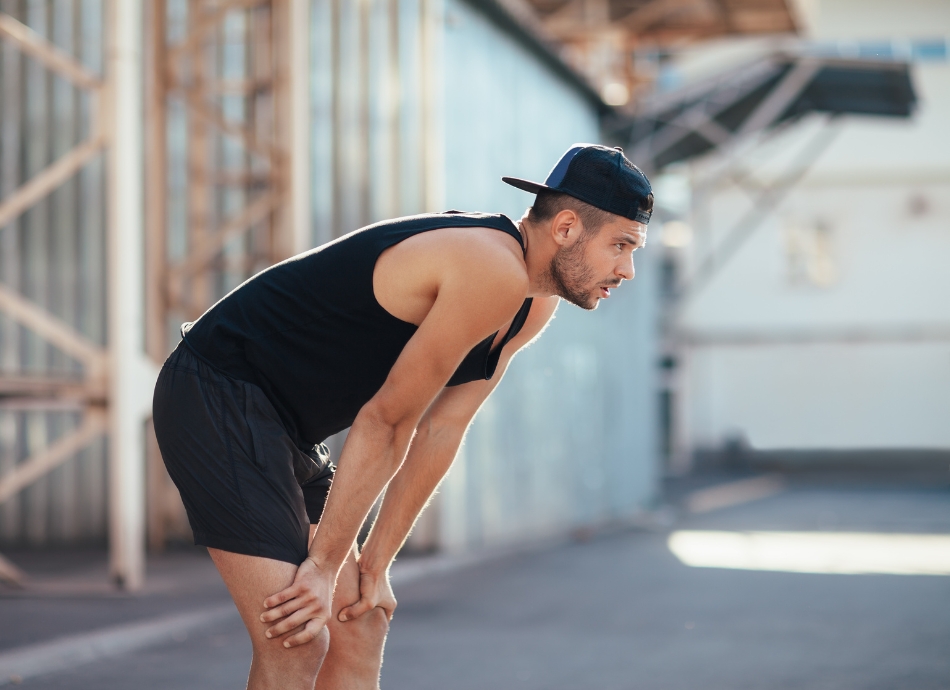
People with a diagnosis of asthma often experience symptoms when they exercise. For some this may be the only time they're aware of symptoms of wheezing, chest tightness, cough and/or breathlessness. This is called exercise-induced asthma (EIA) or exercise-induced bronchoconstriction..
If you find that you cough, wheeze, have a tight feeling in your chest or get breathless when you exercise you may have EIA.
EIA may get worse by cold, dry conditions and if you are unfit. If you have an allergy response (eg, hay fever or eczema) affecting your asthma, exercising when there's a high pollen count may worsen your symptoms. Air pollution may make this worse.
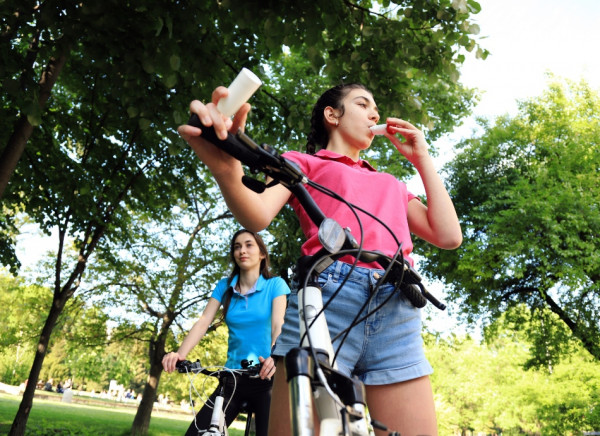
Image credit: Canva
If you experience any of the following symptoms during physical activity, and/or your peak flow drops 20% after exercise, your asthma may be exercise induced. You should see your healthcare provider if you:
- have a tight feeling in your chest
- You're wheezy (have noisy breathing)
- are breathless
- are coughing.
There are 2 theories about the cause of exercise-induced asthma:
- Water-loss theory: Some researchers believe that the cool air you breathe in when you exercise dries the lining of your airways. This triggers your airways to spasm and become tight.
- Heat-exchange theory: Another theory is that increased breathing during activity cools your airways. When activity stops, the blood vessels dilate to heat the lining of your airways. The airways narrow and cause shortness of breath and wheezing.
Don't let EIA slow you down. Have your asthma treatment reviewed and updated. Have fun and stay active. We all know that physical activity is good for us. This is particularly the case if you have asthma. Being active:
- improves lung function
- increases blood flow
- improves the way your body uses oxygen
- has an overall calming effect.
Active people usually find they have fewer asthma symptoms and better control over their asthma. Sport and Recreation New Zealand (SPARC) recommends just 30 minutes of brisk walking, or something equivalent, on most days of the week. This can be in 10-minute bites if squeezing in 30 minutes a day is difficult. Being somewhat out of breath isn't harmful as long as you are in control.
There are just as many world-class athletes with asthma as there are without. They take part in all types of sport, including running, and don't let having asthma get in the way of achieving their goals. They control their asthma – not the other way around.
There are several things you can do to help manage EIA.
Control your day-to-day asthma
- If you have symptoms of asthma more than 3 times a week, your asthma is not well controlled.
- See your healthcare provider to review your medicines and ask for an asthma self-management plan(external link). Make sure you know how to use your inhalers as well and effectively as possible.
- Ask whether you need a breathing test (called spirometry).
- Make sure your inhalers (puffers) are prescribed according to the latest guidelines. This should include a steroid, asthma preventer – possibly in a single combined reliever/preventer device. You may also benefit from a tablet therapy, such as montelukast. Talk to your healthcare provider about the best treatment for you.
- Try to avoid exercising on days when you are experiencing much more severe asthma symptoms than usual, eg, when you are getting a cold. You may still be able to do scaled down exercise.
- If you have hay fever and asthma during the pollen season try to monitor pollen counts and consider choosing indoor activities on days when they're high. Talk to your healthcare provider about the best possible treatment for your hay fever.
Do more asthma-friendly activities
Activities involving stopping and starting or a warm moist environment are less likely to cause EIA. For example, try walking, tramping, tennis, yoga, martial arts, T'ai chi, aerobics or team sports. However, there's no reason why you shouldn't try more intensive activities if you are doing well with less intensive ones.
Remember to warm-up
Stretching and a few minutes of brisk walking or skipping before exercise:
- helps prevent EIA
- protects you from sprains and strains
- gets you in the mood to move.
Check weather conditions
- If you have a choice, exercise inside on cooler, dryer days.
- If you are outside and it's cold, wear a thin, warm scarf loosely around your lower face to help warm the air you breathe.
- Check the pollen count forecasts. The MetService(external link) in Aotearoa New Zealand provides pollen forecasts. They appear in the sidebar to the left of the weather forecast when you search by location.
- Avoid being exposed to heavily polluted air.
Use your reliever inhaler before activity
Many people with asthma now use a single inhaler combining prevent medication with reliever medication. Take 1 or 2 puffs about 15 minutes before exercising.
If you're still using 2 separate inhalers, take 1 or 2 puffs of your reliever medicine (usually blue-coloured) several minutes before you start physical activity. If you need to take reliever medicine more than once after your initial puff, stop your activity session for that day. Using a spacer increases the effectiveness of metered dose inhalers (MDIs).
If you exercise often and you need a dose of reliever before and during your session, ask your healthcare provider to reassess your preventer medications as you may not yet be on the best possible treatment.
Breathe – don't heave
Taking slow deep breaths through your nose with the right breathing pattern can help people with EIA (see below).
Apps reviewed by Healthify
You may find it useful to look at some Asthma apps and Breathing apps.
Breathe through your nose
- It is important to breathe through your nose as this warms, filters and moistens the air that enters your lungs.
- It also helps to regulate your breathing.
- Nose breathing may take practice, especially if you're not used to it.
- If your nose is blocked by hay fever, dust mite allergy or sinusitis, ask your doctor about nasal treatments.
- Controlling any allergies and clearing your nose can make a big difference to your daily life and to your asthma.
Use your diaphragm to breathe
Your diaphragm is a large muscle separating your lungs from your abdomen. Your diaphragm can work hard and never get tired. Some people breathe using their chest muscles instead of their diaphragm. This takes extra effort and can cause fatigue and tension.
Test yourself to see whether you breathe correctly through your diaphragm (diaphragmatic breathing):
- Sit upright and relax your shoulders.
- Rest one hand on your chest and the other on your stomach.
- Breathe in deeply through your nose and pay attention to the movement of your hands.
- If you are using your diaphragm to breathe, the hand on your stomach will move.
- If you are using your chest muscles to breathe, the hand on your chest will move.
- Practice both ways of breathing and feel the difference.
If you are a chest-breather, practice diaphragmatic breathing for a few moments several times a day. Soon, diaphragmatic breathing will be automatic.
Relax while breathing out
It's important to relax and let the air flow out of your lungs slowly and freely. Take a moment to remind yourself how good it feels.
- Sit upright and relax your shoulders.
- Remember to breathe through your nose.
- Using your diaphragm, breathe in gently and fully, then just let go.
- Feel the air flow out fully and effortlessly.
Practice relaxing while you breathe out, and it will become automatic.
Breathe rhythmically
Most people breathe faster when they are tense or anxious. Their breathing becomes short and shallow. This type of breathing is both inefficient and tiring, and it can make you feel uptight or frightened.
Slow rhythmic breathing can help calm you. Practice this exercise several times a day.
- Sit upright and relax your shoulders.
- Breathe in gently and fully using your diaphragm.
- Let your breath flow out freely.
- To slow down, pause a moment before your next breath in.
- Aim for a rhythm of about 10 to 14 breaths per minute.
Exercise-induced asthma(external link) Mayo Clinic, US
Asthma medication(external link) Asthma + Respiratory Foundation, NZ
Brochures
GINA patient guide – you can control your asthma(external link) Global Initiative for Asthma English(external link), Chinese(external link), Spanish(external link), Turkish(external link)
NZ adolescent and adult asthma guidelines(external link) Asthma + Respiratory Foundation NZ
Breathing and asthma(external link) Asthma + Respiratory Foundation, NZ
Summer holiday asthma and allergies checklist(external link) Asthma + Respiratory Foundation NZ
Asthma checklist(external link) Asthma + Respiratory Foundation NZ
Apps
References
- Exercise-induced asthma(external link) Mayo Clinic, US, 2022
Some medical experts in particular in North America are keen to separate the terms exercise-induced asthma and exercise-induced bronchoconstriction, stating that the latter can occur in individuals without a formal diagnosis of asthma, which is a generally life-long respiratory condition. Any individual with symptoms should be tested for asthma and considered for asthma treatment.
See our page Asthma in adults for healthcare providers.
Brochures
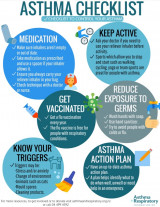
Asthma checklist Asthma + Respiratory Foundation, NZ
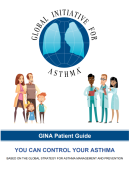
GINA patient guide – you can control your asthma Global Initiative for Asthma
English, Chinese, Spanish, Turkish
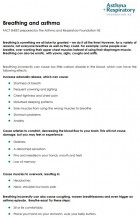
Breathing and asthma Asthma + Respiratory Foundation, NZ, 2010
Credits: Healthify editorial team. Healthify is brought to you by Health Navigator Charitable Trust.
Reviewed by: Dr Roland Meyer, Specialist Physician, Respiratory and General Medicine
Last reviewed:





